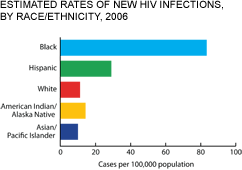The US Conference on AIDS has begun in Fort Lauderdale, unfortunately I couldn’t afford to go, but just as well because I am going to see my southern friends at Southerners on New Ground’s 15th Anniversary. But given the CDC’s recent release of the of the subpopulation data of the new infections for 2006 (called incidence), I thought I’d share some of the data with you. If you click on the link above you’ll find a lot of other tools to help you understand the data including a fact sheet, a Q&A, and a podcast:
CDC’s August 2008 data showed that gay and bisexual men, referred to in CDC’s surveillance systems as men who have sex with men (MSM)2, represented the majority of new infections in 2006 (53%, 28,720).
Now, in the more detailed analysis, CDC further examine new infections among whites, blacks, and
Hispanics/Latinos. The findings reveal that the ages at which MSM become infected vary by race:
- Young Black MSM: Among MSM overall, there were more new HIV infections in young black MSM (aged 13–29) than any other age/racial group of MSM. The number of new infections among young, black gay and bisexual men was roughly twice that of whites and of Hispanics/Latinos (5,220 infections in blacks vs. 3,330 among whites and 2,300 among Hispanics/Latinos).
- White MSM in their 30s and 40s: Among MSM in the analysis, white MSM accounted for close to half (46%) of HIV incidence in 2006. Most new infections among white MSM occurred in those aged 30–39 (4,670), followed by those aged 40–49 (3,740).
- Hispanic/Latino MSM: Among Hispanic/Latino MSM, most new infections occurred in the youngest (13-29) age group (2,300), though a substantial number of new HIV infections were among those aged 30–39 (1,870)
Walt Senterfitt, in this month’s HHS Watch (a publication of Community HIV/AIDS Mobilization Project (CHAMP)), writes about what the new data means for gay men in his piece called Where’s Our National Campaign Against Homophobia?
There has also been a consistent tendency over at least the last 15 years within much of the AIDS community itself – and certainly by the media and other institutions of civil society enlisted in the struggle against HIV/AIDS – to “de-gay-ify” HIV/AIDS. For example, messages stress that HIV is an “equal opportunity virus” and that anyone can be at risk, emphasize children and women at risk, and stress that HIV/AIDS is, in its majority, now an epidemic in communities of color (while simultaneously neglecting to stress that those most disproportionately impacted in communities of color are gay and bisexual men).
This direction in messaging was in part well intended, to combat the widespread assumption that if you are not a white gay man, AIDS is not your problem and you are not at risk. It was also meant to get beyond the intensified stigmatization of gay men and focus on the behaviors that put one at risk. This approach has been embraced by many HIV positive and other gay men who fear the added stigmatization of having “gay” remain widely associated with “HIV/AIDS” in public consciousness. Even from the start though, this approach was a capitulation to rather than a confrontation of societal stigma and prejudice against gay people, against transgender people, against all people who are sexually “non-normative.” And it didn’t work. Homophobia still is rampant, dollars have gone elsewhere, and, alone among the exposure categories, HIV infection rates among gay men are rising.
Here’s video from a panel CHAMP sponsored (that I moderated) back in February on the issue:
[youtube=http://www.youtube.com/watch?v=ObFD-VwNFCg]

